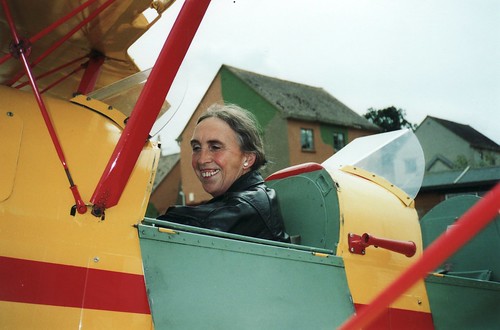
Jack and Jan chatting before the flight (Photo: Rita Upchurch)
As instructed, I stepped carefully onto the lower wing and levered myself into the front seat.

Jan in the front seat before the flight (Photo: Rita Upchurch)
Jack followed into the pilot's seat, wearing flying overalls and World War II leather flying helmet incorporating earphones and facemask with microphone, with the cable held in his mouth, presumably to prevent it from becoming trapped as he sat in the restricted space.

Jack boarding the cockpit (with headset lead held in his mouth) before the flight (Photo: Rita Upchurch)
The gentleman serving as ground crew arrived with the 5-point safety harness, trussed me into position and supplied me with a modern version of the flying helmet with miniature earphones and a boom microphone.

Ground crew arranging Jan's harness and headset before the flight (Photo: Rita Upchurch)
Once the headsets were plugged into their jacks, there was two-way speech between Jack and I.

Jack and Jan before the flight (Photo: Rita Upchurch)
The Stampe has open cockpits, with a small windscreen in front of each to give some protection from the airflow. The ground crew carried out the final checks before closing the hinged access flaps on each side of the cockpit which had been lowered to allow access on the ground. When raised and latched, they offer some protection from the airflow.

Ground crew carrying out final checks before the flight (Photo: Rita Upchurch)
Checks complete, the De Haviland Gipsy Major 10 engine was started and Jack taxied the aircraft to the grass runway 10/28. The take off run was a little bumpy on grass but what impressed me, more used to larger jet aircraft, was how quickly the aircraft seemed to float off the ground without effort. As Jack climbed away from the runway, I was expecting a sightseeing trip. When one wing dipped to point to the ground, it seemed a good way to admire the countryside - the view ahead in level flight didn't show much of the ground. But, with increasing horror, I realised that Jack was continuing the roll so that my harness suddenly tightened as the seat, unaided by gravity, failed to support me as we flew inverted. I experienced terror as I realised that the five straps of my harness were all that prevented me from plunging to earth. Jack rolled the aircraft right way up and immediately started a steep climb which again involved being inverted at the top of the loop.
After the flight, I discovered that Jack was executing a standard series of what he called 'simple' aerobatic manoeuvres, accurately timed and positioned in a three-dimensional 'box'. But at the time, the assault on my senses was almost overwhelming and I started to feel sick. I think it was only the humiliating thought of actually throwing-up in the aircraft (no sick bags were provided) which allowed me to control the urge. I considered using the intercom to ask Jack to stop but my curious thought was 'if he stops now, I'll never have the confidence to attempt it again, so I'd better keep quiet'. On the rare occasions Jack spoke to me on the intercom, I somehow managed to reply in a fairly normal voice, suppressing my feeling of panic. I have no clear recollection of the various manoeuvres Jack executed but new (and unwelcome) sensations kept occuring as we moved through the programme. I remember at one point Jack saying "There's Leeds Castle" (about six miles from Headcorn) and dropping a wing to give a better view. I don't think the manoeuvres lasted long before we entered a period of 'staight and level' flight. At first, I was very relieved but I soon started to think how boring it was, compared with the preceding excitement which had so terrified me. We were soon back at Headcorn and made a gentle landing.

Pilot's view on approach to Runway 28 at Headcorn (from Headcorn Aerodrome website)
When the engine stopped, I felt completely disorientated. Getting into the aircraft hadn't been easy but getting out almost defeated me. Once I was finally back on the grass, my sense of balance had almost deserted me and for some minutes I staggered about as if inebriated. My deception on the intercom had been convincing and Jack said he had no idea of the terrors I had experienced. After a few more minutes, I felt completely recovered and found myself saying "When can we go again?". Jack checked on the bookings for the rest of the day, but there was no availability and, to date, that remains my only aerobatic flight.

Map of Headcorn Aerodrome, ICAO designator EGKH (from Headcorn Aerodrome website)
The Stampe SV.4 Aircraft
The Stampe SV.4 was a Belgian design in 1933 by George Ivanov for Stampe et Vertongen of Antwerp as a tourer and trainer. 35 aircraft were built before closure prior to World War II. Post-war, successors Stampe et Renard built a further 65 plus 940 built under license by SNCAN in France and an Algerian firm. There's a Wikipedia article on Stampe here.
The aircraft I flew in is a post-war model SV.4C
Engines used on Stampe aircraft
The Stampe SV.4 uses a 4-cylinder, air-cooled in-line inverted aero engine. For aircraft use, the engine crankshaft must be high enough off the ground to give the propellor clearance under all conditions. In a inverted engine, the cylinders are placed underneath the crankshaft, allowing the pilot an unobstructed view ahead. Renault engines were commonly used but the De Haviland Gipsy Major was also used.
I believe the aircraft I flew in is equipped with Gipsy Magor 10 Mark I.There's an article on the Gipsy Major engine here.
Pictures
.
